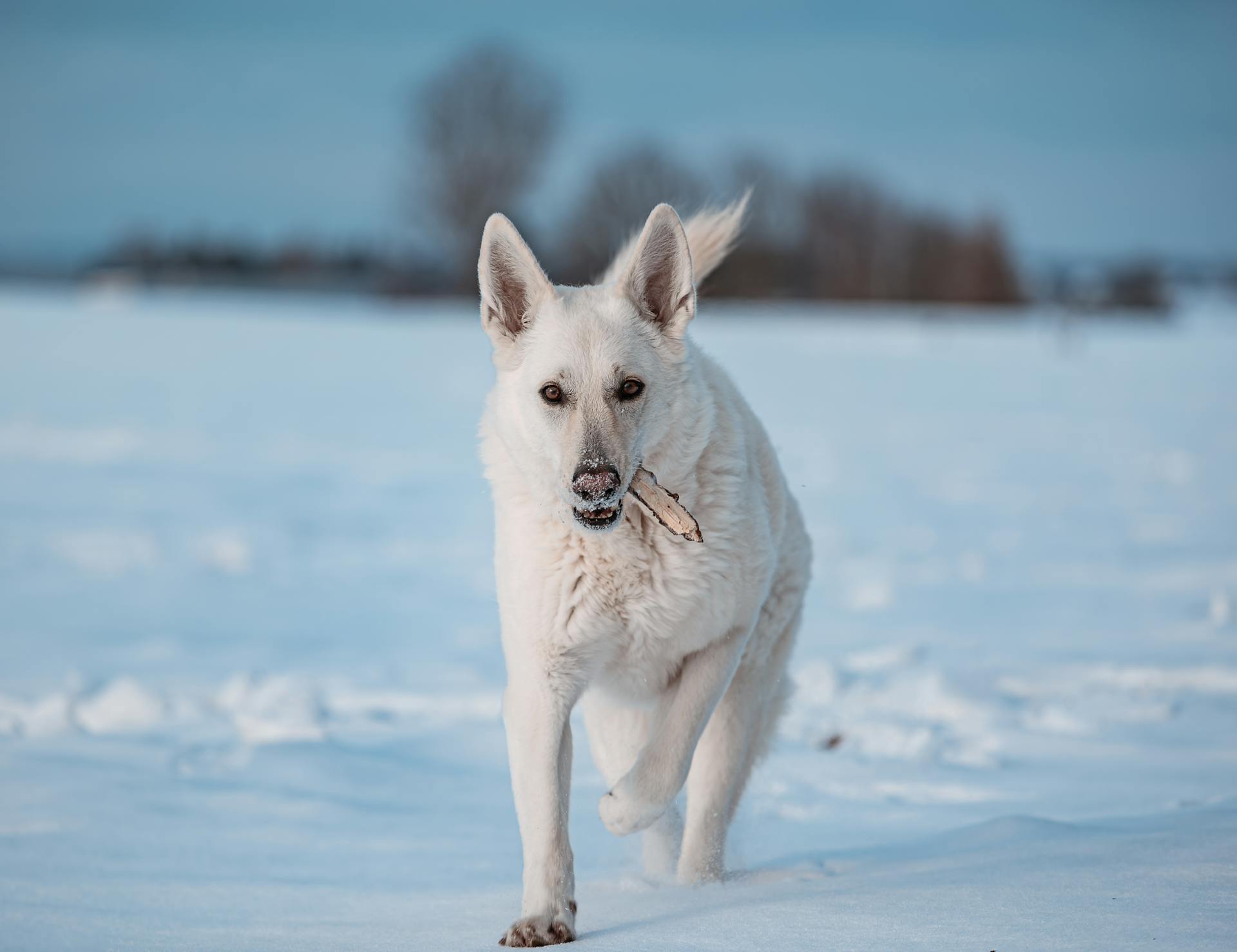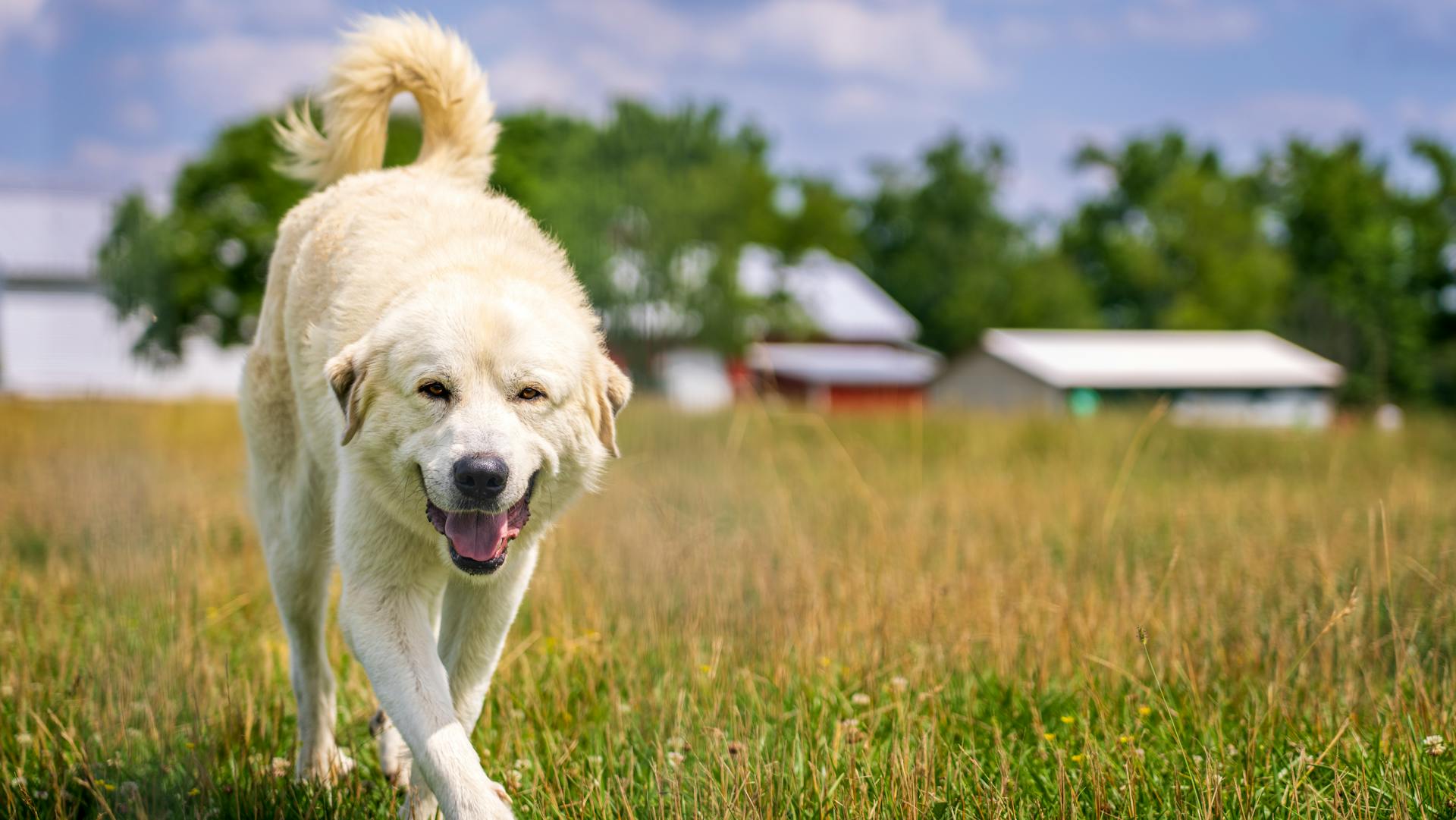
The Great Pyrenees is a majestic breed that originated in the Pyrenees Mountains between France and Spain. They were originally bred to guard sheep and other livestock from predators.
Their thick double coat is perfect for withstanding harsh mountain weather conditions. This coat requires regular brushing to prevent matting and tangling.
Great Pyrenees are known for their calm and gentle nature, making them a great addition to families with children. However, they can be wary of strangers and may require time to warm up to new people.
Their intelligence and independent thinking make them a challenge to train, but with patience and consistency, they can learn to obey commands and behave well.
Here's an interesting read: Great Pyrenees Coat Colors
Appearance
The Great Pyrenees is a majestic breed with a commanding presence. Their bright white coats and large muscular frame make them stand out in any setting.
Their rounded head is a distinctive feature, and their intelligent brown eyes hold a quiet gaze that's both soothing and alert. These eyes are medium-sized and almond-shaped.
Consider reading: Great Pyrenees Eyes

A Great Pyrenees' nose is black and rounded in shape, adding to their dignified appearance. The breed's ears are small to medium in size, V-shaped and rounded at the tips.
Their thick double coat is a hallmark of the breed, with a long, flat outer coat and a dense, wooly undercoat. This coat helps them thrive in cold mountain climates.
Male Great Pyrenees often sport a ruff or mane, with more abundant fur growing around the neck and shoulders. This adds to their regal appearance.
Great Pyrenees come in two main coat colors: all white or white with some markings in reddish brown, badger, tan, or gray. Their tails are long and feathery, with longer hair than the rest of their body.
Here's a quick summary of their key features:
- Ears: Small to medium in size, V-shaped and rounded at the tips.
- Eyes: Medium-sized, almond-shaped and dark brown.
- Nose: Black and rounded in shape.
- Coat: Thick double coat with long, flat outer coat and dense, wooly undercoat.
- Coat Color: All white or white with markings in reddish brown, badger, tan, or gray.
- Tail: Long and feathery, with longer hair than the rest of their body.
Personality and Temperament
The Great Pyrenees is a gentle giant, known for its calm and gentle demeanor. They are intelligent, calm, and gentle dogs when well trained and socialized.
Their temperament is a perfect fit for families with children who understand how to interact with dogs. However, they may be best in homes without smaller children who may be easily harmed by an accidental bump from a 100-pound dog.
Great Pyrenees are incredibly affectionate with the members of their family, but they tend to be reserved around strangers. Early socialization is key to helping them become confident and calm in new situations.
They are natural guard dogs, bred to watch over sheep in the mountains, and can be strong-willed at times. This means they need early socialization and training to help them become well-mannered and obedient.
A calm, gentle, docile demeanor is the norm for a Great Pyr. They are courageous and devoted to their people, making them the best friend anyone could ask for.
Great Pyrenees are intelligent and used to working on their own, which can make them independent thinkers and sometimes stubborn. However, with the right training and socialization, they can become loyal and loving companions.
If this caught your attention, see: Great Pyrenees Dogs 101
Care and Feeding
The Great Pyrenees is a high-maintenance breed that requires regular grooming to stay handsome and healthy. You'll need to work to ensure their coat looks its best.
To prevent tartar buildup and gum disease, brush your Pyr's teeth at least two or three times a week, or daily for optimal results. This will also help prevent bad breath.
A Great Pyrenees' diet consists of 4 to 6 cups of high-quality dry food per day, divided into two meals. However, this amount can vary depending on your dog's size, age, build, metabolism, and activity level.
To ensure your Great Pyrenees stays in good shape, measure their food and feed them twice a day, rather than leaving food out all the time. This will help prevent overeating and maintain a healthy weight.
To check if your dog is overweight, look down at them and see if you can spot a waist. You should also be able to feel their ribs without pressing hard. If you can't, they need less food and more exercise.
Expand your knowledge: Great Pyrenees Diet
Great Pyrenees are prone to bloat and GDV, a serious condition that can be prevented by taking precautions when feeding your dog. Feed them multiple small meals throughout the day, avoid vigorous exercise around mealtimes, and use a slow-feeder food bowl to slow them down as they eat.
Here's a quick guide to feeding your Great Pyrenees:
Remember to discuss your dog's diet with your veterinarian, as they can make recommendations based on your pup's specific medical history and lifestyle.
Coat Grooming
A Great Pyrenees' coat is surprisingly resistant to dirt and tangles, but they still need weekly brushing to keep them clean and mat-free.
You'll want to use a slicker or rake brush to help remove loose hair and prevent matting. A monthly bath is plenty, and if you do find matted fur, ask your vet about de-matting conditioners.
Their undercoat sheds a lot, leaving a white trail all over your home, so be prepared for regular brushing sessions. In fact, you may need to add an extra brushing session or three to your routine to combat the blizzard of loose hair.
Curious to learn more? Check out: Great Pyrenees Exercise Needs
Remember to keep an eye on your Great Pyrenees' nails, which should be trimmed about every two weeks or anytime they start to touch the floor when the dog is standing. You'll hear when it's time – they'll clack-clack-clack on hard surfaces.
Daily brushing is a must for your Great Pyrenees' dental care, and you should also take them to the vet yearly for a professional cleaning to keep plaque at bay.
Consider reading: What Age Do Great Pyrenees Stop Growing
Training
Training a Great Pyrenees requires patience and consistency. They're independent thinkers and may not respond to every command, but with positive reinforcement and rewards, they'll learn.
Great Pyrenees were bred to be independent flock guardians, which can make training challenging. Enrolling them in obedience classes can help.
Keep training sessions short to avoid overwhelming your pup. They have a strong instinct to roam, so it's essential to keep them within a sturdy fence.
Great Pyrenees are intelligent, but they're not as responsive to training as some other breeds. They'll get there with time and effort, but don't expect them to excel in obedience and competitive sports.
Explore further: Great Pyrenees House Training
Consistency and positive reinforcement are key to successful training. Early socialization is also crucial to help them become well-mannered and comfortable in new situations.
Training and socializing a Great Pyrenees from an early age is vital, especially since they have a strong guarding instinct. Start with basic obedience training using positive reinforcement as soon as possible.
Exposing your Great Pyrenees to various environments, people, animals, sights, and sounds will prepare them to be confident and calm in any situation.
Here's an interesting read: Training a Great Pyrenees
Health and Environment
The Great Pyrenees is a majestic breed that requires careful consideration of its health and environment needs. They thrive best in cooler locations, with access to plenty of fresh, cool water, especially in warmer climates.
Their lifespan is relatively short, ranging from 10 to 12 years, and they're prone to several health issues. Bloat, a genetic condition, can be life-threatening if not treated immediately.
Regular vet visits and a healthy diet and exercise routine can help prevent or manage these health issues. Feeding smaller meals more frequently and using a slow feeder can help prevent bloat.
Here are some common health issues that affect the Great Pyrenees breed:
- Bloat or Gastric Dilatation-Volvulus (GDV)
- Eye Conditions: Canine multifocal retinopathy, cataracts, and entropion
- Deafness
- Neurological Disorder: Neuronal Degeneration (NDG)
- Hip and Elbow Dysplasia
- Patellar Luxation
Health
The Great Pyrenees is a generally healthy breed, but like all dogs, they can be prone to certain health issues. They have a lifespan of 10 to 12 years, which is a little longer than the average life expectancy for giant dogs.
Bloat, also known as Gastric Dilatation-Volvulus (GDV), is a genetic condition common to big dogs that can be life-threatening if not treated immediately. To prevent bloat, feeding your Great Pyrenees smaller meals more frequently throughout the day and using a slow feeder can be helpful.
Eye conditions such as canine multifocal retinopathy, cataracts, and entropion can affect this breed and cause vision loss or blindness. Surgery can be performed to remove cataracts and correct entropion.
Deafness can appear in any breed, but it's more prevalent in dogs with white skin and fur, like the Great Pyrenees. Dogs who lose hearing tend to do very well at home with minimal accommodations.
Broaden your view: Breeds Similar to Great Pyrenees

Neuronal Degeneration (NDG) is an inherited disease that causes changes to the nervous system, leading to symptoms such as clumsiness and hind leg issues. Unfortunately, there is no cure or treatment for NDG, but genetic screening testing is available.
Hip and elbow dysplasia, patellar luxation, and other joint development conditions can affect the Great Pyrenees due to their size. These conditions can lead to lameness, pain, and arthritis, and treatment options include weight management, joint supplements, pain medication, and surgery.
Here are some common health issues that can affect the Great Pyrenees, along with their symptoms and treatment options:
Environment
Great Pyrenees are happiest with acres of land to roam, but that's not always feasible, so consistent outings are a must.
They're built for cooler climates, having originated on snowy mountain tops, and can be sensitive to warm weather.
If you live in a warm area, plan outdoor activities for the cooler parts of the day and ensure your pup has access to fresh, cool water.
In extreme cold, it's essential to balance your Pyr's love of the outdoors with their need for protection from the elements.
A Great Pyr's ideal environment is cooler, not freezing, so find a happy medium for your pup's comfort.
You might like: Why Do Great Pyrenees Bark so Much
History and Rescue
The Great Pyrenees has a rich history that spans thousands of years, with roots dating back to the Bronze Age or 1800 to 1000 BC. This powerful breed was originally bred to work with peasant livestock herders in the Pyrenees mountains.
Their job was to protect sheep flocks at night from animal predators and thieves, which explains their natural tendency to bark and be nocturnal. The breed's guarding skills were so impressive that King Louis XIV even bestowed the special moniker "Royal Dog of France" upon the Great Pyrenees breed.
In the 1600s, the reputation of the Great Pyrenees' amazing guarding skills reached the French nobility, leading to knowledge about the breed becoming slightly more widespread. This breed was officially recognized by the American Kennel Club in 1933 as a member of the Working group.
Additional reading: Is a Great Pyrenees a Giant Breed
History
The Great Pyrenees has a rich history that spans thousands of years. The breed's lineage dates back to the Bronze Age, around 1800 to 1000 BC.

Originally bred to work with peasant livestock herders, the Great Pyrenees was later adopted by French royals and the noble class to guard castles in southwest France. They were even given the special moniker "Royal Dog of France" by King Louis XIV.
The Great Pyrenees' job was to protect sheep flocks at night from predators and thieves, and they were naturally nocturnal. They would sound the alarm with their high tendency to bark if anyone suspicious approached.
The breed was brought to the U.S. in 1824 by the Marquis de Lafayette, a great French military officer who served alongside George Washington during the American Revolution. They continued their military service with heroism during World War II, hauling artillery supplies over the Pyrenees mountains in frigid weather.
The Great Pyrenees' ancestry is believed to date back ten to eleven thousand years to dogs who originated in Asia Minor. Their ancestors came to the Pyrenees Mountains around 3000 B.C. where the breed was developed to create a dog who would aid shepherds.
The breed was first considered a dog owned by peasants, but in 1675, the Dauphin in the court of King Louis XIV declared that the Great Pyrenees was the Royal Dog of France. This prompted the French nobility to acquire Great Pyrenees and use them to guard estates.
Explore further: Great Pyrenees Breed Standard
Rescue Groups
If you're considering adopting a Great Pyrenees, it's essential to work with a reputable rescue group. Great Pyrenees Rescue Groups are dedicated to finding forever homes for these gentle giants.
Many people acquire Great Pyrenees without fully understanding the commitment involved, and these dogs often end up in the care of rescue groups. If you're interested in adopting a Pyr, a Great Pyrenees rescue group is a good place to start.
Some notable Great Pyrenees rescue groups include:
- National Pyr Rescue
- Great Pyrenees Club of America Rescue
- Great Pyrenees Association of Southern California Rescue
- Great Pyrenees Rescue of Greater Chicago
Family and Pets
The Great Pyrenees is a loving and protective breed that makes a great addition to many families. They are absolutely devoted to their children and will protect them with their life.
Young children need to be supervised when interacting with a Great Pyr, as they can be too large to manage on their own. Teach your child how to approach and touch dogs gently, and never leave a child unsupervised with a dog.
A Great Pyrenees tends to get along well with other animals in the house, especially if they've been raised together from puppyhood. They're also known to do very well around cats, especially if they're socialized with them from an early age.
Early socialization is key to helping a Great Pyrenees be their best self, and they can thrive in urban households as well as rural ones. With patience and routine, they can be very well-mannered and trustworthy companions.
Children and Pets
The Great Pyrenees is a loving breed that adores children, but it's essential to supervise interactions between them.
They're naturally protective of kids and will defend them if needed, but young children shouldn't be left alone with a Great Pyrenees due to its large size.
Teach children how to approach and touch dogs gently, and supervise interactions between dogs and young children to prevent any accidents.
A well-socialized Great Pyrenees tends to get along with other animals in the house, especially if it's been raised with them from puppyhood.
For more insights, see: Are Great Pyrenees Herding Dogs
Great Pyrenees are generally good with other pets, but early socialization is key to ensure they're well-behaved around them.
They're not often found excelling in obedience competitions because of their independent nature, but with patience and routine, they can be very well-mannered companions.
Supervise your child when they're interacting with a Great Pyrenees, especially around mealtime or when the dog is sleeping, to prevent any conflicts.
With proper training and socialization, a Great Pyrenees can thrive in a family environment and make a wonderful companion for kids and adults alike.
Related reading: When Do Great Pyrenees Get Their Full Coat
Do Cats Like It?
The Great Pyrenees can get along great with cats, especially when they're well trained and socialized from an early age.
They're naturally protective of smaller animals, which makes them less likely to harm cats.
If you have a Great Pyrenees and a cat, introducing them to each other at a young age is key to a harmonious household.
Socialization is crucial in this case, as it helps the Great Pyrenees understand that cats are not a threat.
With proper training and socialization, you can enjoy a happy and peaceful home with both your Great Pyrenees and your cat.
Expand your knowledge: Great Pyrenees Age
Frequently Asked Questions
Are Great Pyrenees good watchdogs?
Yes, Great Pyrenees are excellent watchdogs due to their natural instinct to protect their flock at night. Their barking habit at night makes them a great deterrent against unwanted strangers.
What two dogs make Great Pyrenees?
The Great Pyrenees is a cross between the Maremma Sheepdog and the Anatolian Shepherd. Its ancestors date back to ancient times, with origins potentially tracing to 1800 B.C.
Featured Images: pexels.com


